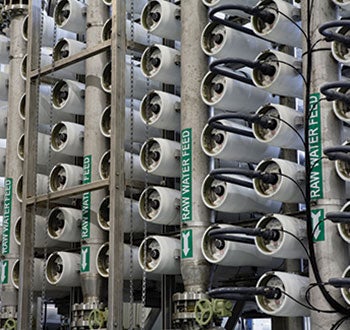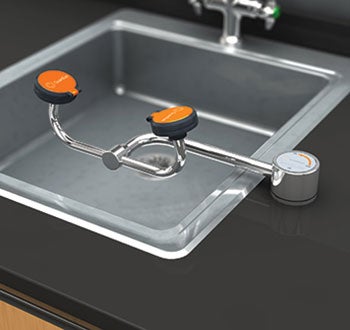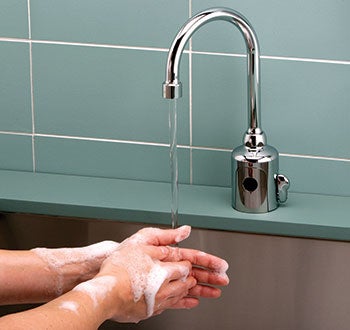Hospital plumbing systems

Simplicity and reliability are keys to designing hospital plumbing systems. Moreover, planning for operational efficiencies will keep these systems functioning optimally over the life of a facility.
Knowing the demanding requirements of health care plumbing systems and the technical challenges specific to each hospital, as well as relevant codes and standards, will aid facilities personnel in maintaining these unique systems and fixtures.
Plumbing systems

A reverse-osmosis membrane housing array generates purified water for laboratory use, an integral step in processing purified water.
There are a number of plumbing systems that are unique to hospitals. This equipment will have distinctive requirements and maintenance considerations that must be understood for the hospital’s infrastructure to run efficiently.
Dialysis systems. There are two ways to approach plumbing infrastructure for dialysis systems — portable water filtration carts or a reverse osmosis (RO) system. The health care facility selects the type of portable equipment that will be employed, which will then determine the need for purified and tap water delivery at the dialysis box.
You may also like |
| Flint hospitals work to protect water supply |
| Understanding legionellosis protection requirements |
| Preparing for water supply disruptions |
|
|
When portable water filtration carts are used, only a municipal tap water hookup is required. Typically, the water cart is rented and even may be maintained by a third party. Facilities personnel might need to consider this type of outside maintenance expense in their annual budget.
On the other hand, a reverse osmosis system is specified to deliver filtered water directly to the dialysis machine. It will require a water softener, charcoal filter and some type of chlorine destruct to reduce the amount of chlorine in the water. While widely used, the RO system will require greater up-front capital costs, maintenance and monitoring by the hospital facilities staff.
Laboratory systems. Purified water is used for hospital lab testing, pathology and more. Considerations include maintaining makeup water connections and the water purification system in a way that prevents backflow, so there’s no human contact with the water after it leaves the lab.
Labs require many different types of water, depending on their function. From a maintenance standpoint, there’s a minimum requirement for RO water in some labs, but also a requirement for deionized water. Coordinating the equipment, how the water is being filtered and the filter maintenance will be critical. Will the system accept municipal tap water to make filtered water or will there be an array of filters to make highly filtered water? How can the system be maintained optimally? Again, employing a third-party vendor to manage the system and its filters is possible. Where this is a luxury, health facilities professionals should consider the required upkeep and how this role can be fulfilled by the current facilities staff.
On the waste side, staff will need to account for purified water and chemicals that leave the lab. Point-of-use or acid-neutralizing systems will be employed. All specialty equipment, especially waste because of its ability to spread chemicals and disease, needs monitoring points connected to the building automation system (BAS) to notify facilities personnel whenever something goes wrong. Facilities professionals should make sure the lab waste systems are connected to the BAS and determine who will receive the alarms when there is a malfunction or one of the waste system components needs maintenance.
Central sterile systems. Known as the hospital’s assembly line for surgical tools, the central sterile system will have a large water demand that fluctuates considerably. Therefore, the hospital’s water supply must be designed to accommodate this.
The current trend in hospital design is to build satellite decontamination rooms near the operating room (OR) so that equipment can be cleaned and returned in less time, instead of having to transfer dirty and sterile utensils back and forth to the large central sterile area on another floor.
The central sterile system also will have a large drainage dump load — whatever goes in must come out of the equipment. Because the equipment will pull in water and get rid of it quickly, the drainage system either needs to be large enough to handle the high flow, or be designed with a holding tank to handle the capacity and provide a slow drain-off. Backflow preventers will need to be employed, including water softeners.

Regulations require testing of emergency plumbing equipment, such as this eye/face wash unit.
Sterilizer systems. Sterilizers are employed in many key functions of a hospital — from the OR to procedure rooms, gastrointestinal areas, nurse stations and more. They typically have minimum temperature requirements, designed to wash and rinse probes at 160 to 180 degrees F.
It is critical that the minimum temperature requirement of water delivery be met immediately and for the duration of the sterilization start-up cycle as opposed to having the equipment heat up the water to the desired temperature. This is an important consideration when maintaining sterilizers to ensure that the systems don’t default to an error.
Backflow prevention and temperature mixing valves must be included in each sterilizer as well. From the facilities standpoint, this is a lot to maintain. Although backflow equipment isn’t designed to be hooked up to the BAS, it must be tested annually to make sure it is working correctly.
Pathology lab systems. Pathology labs differ from general labs in that they feature chemicals that can foam up. To prevent this, anti-foaming agents and drain covers should be employed. Because of the foam and unique chemicals used, the pathology lab will have different water requirements and feature its own filtration systems. A thorough understanding of how these systems operate and the different levels of water quality that need to be produced for the pathology lab is critical.
To neutralize pathology chemicals, special anti-foaming waste receptacles may be required and will have to be maintained. Because of these unique features, the pathology lab waste system will need to be connected to the BAS. The BAS must be set to notify facilities personnel of a pathology lab waste system failure. Again, where specialized equipment is employed, a third party may be retained for maintenance. If so, there may be downtime when repairs are required. Staff must consider how this will affect the pathology lab’s work.
Emergency plumbing systems. The specification of the three types of emergency plumbing systems — eye washes, eye/face washes and combination emergency shower systems — will be dictated by the specific hazards in each room.
Occupational Safety and Health Administration rules mandate that eye washes, eye/face washes and emergency showers should be tested weekly to make sure they operate correctly. The American National Standards Institute also has strict regulations on water temperature, flow rates, fixture performance (i.e., spray patterns) and devices (i.e., hands-free).
Because these systems produce a lot of water and hospitals could have hundreds of these fixtures, they can make a big mess during testing. Therefore, testing must be planned, with testing areas roped off to maintain safety and proper cleanup.
Domestic hot water systems. While the domestic hot water system will come from the same source as the hospital’s general domestic water system, generation and maintenance directly will affect a hospital’s hot water availability and its temperature control.
Steam is the simplest to maintain — a few control valves and condensation pumps are all that will require maintenance or replacement. With gas generation, burners will have to be maintained more frequently than a steam heat exchanger bundle and storage tanks will be required to preserve gas on-site.
When gas and steam aren’t possible, electrical energy generation usually will require a lot of electrical capital on the front end of the design. This includes the installation of transformers, which require maintenance to power the electric water heaters.
The effectiveness of heating goes down when calcium deposits appear on the water heaters. Therefore, electric water heating is less practical due to a hospital’s high hot water demand, which could require several hundred kilowatts of daily electricity.

Consistency in product specification is key to selecting hospital fixtures.
Renewable energies have the potential to be more efficient energy generators, but their ability to contribute significantly to the hot water heating system will fluctuate depending on location and climate. This is a risk hospitals may not want to take for a primary hot water heating source. Additionally, solar panels will take up valuable rooftop real estate, requiring heat exchangers and additional maintenance.
To prevent scalding and burning, end-user patient contact faucets are code-mandated with strict limitations for water temperature delivery. While the typical hotel or office building delivers hot water at 120 to 140 degrees F, water for standard hospital hand washing and showering is delivered at 110 degrees F. Moreover, water delivery is limited to 100 degrees F on psychiatric floors and areas for patients with dementia. Devices are employed to achieve the desired temperature control, including master mixing and digital recirculation valves, while point-of-use or centralized controls direct the set points.
Master mixing valves are cost-effective, but can incur temperature creep because they don’t have a great flow capacity, so more of them may be required to meet the system peak flow rate. While they cost more, digital recirculation valves require less equipment and deliver more precise temperature control. They also feature BAS connectivity, data logging and simplified maintenance because they can self-diagnose problems.
Traditional mixing valves may be employed at the point of use. This approach requires more valves under each sink and is maintenance-intensive. However, it delivers more accurate temperature control because the temperature is fixed at the point of use.
Fixture specifications
Consistency in product specification is key to selecting hospital fixtures. It’s better not to have six different electronic faucets and nine different manual faucets in one hospital project. Instead, facilities professionals should focus on a one-size-fits-all solution, so that facilities personnel can address it quickly when it needs maintenance. Typically, it’s better to have fewer spare items that need to be stocked.
Additionally, heavy-duty, commercial-grade fixtures will be able to withstand a hospital’s high-traffic use and ensure that facilities personnel aren’t fixing broken toilets all day long. Some fixtures typical to a hospital space with unique maintenance requirements include patient care modules and surgeons’ scrub sinks.
Patient care modules are unique fixtures that combine two or three plumbing fixtures into one cabinet that fits into a compact space. Typically used in intensive care unit (ICU) rooms, where a toilet is required by code, patient care modules aim to disguise the toilet by folding or tucking it away or allowing it to double as a patient room visitor chair.
When patient care modules must be specified, they should be easy to clean and made of durable materials (i.e., solid surface and not laminate). Ideally, it’s best to have fewer mixing parts to alleviate maintenance issues.
Maintenance issues typically arise with specifying patient care modules when the laminate peals off or they begin to leak. Because the toilet can move, its drainage connection isn’t as solid as that of a permanent toilet. Instead, when possible, specifying fixed toilets and solid-surface finishes will help to avoid having to maintain them on a regular basis.
Surgeons’ scrub sinks located outside of the OR are deep basins used for hand washing up to the elbows upon entering and exiting the OR. These sinks must work in conjunction with hospital infection control protocol, which requires the staff to be able to wash their hands without first using them to turn on the water.
Typically they feature infrared, knee or foot activation. Faucet activation may be either an infrared sensor or knee operation and should be coordinated with the owner.
Most scrub sinks will have big bowls with electronic faucets on top. Again, maintaining consistency of specification will aid in efficient maintenance when required. Then, if something breaks, parts can be sourced quickly.
Evolving systems
In today’s ever-changing world of health care, flexible, reliable and easy-to-maintain plumbing systems are the antidote to costly hospital shutdowns that can result in the inability to provide patient care.
Something as simple as a failing faucet could render a patient room no longer usable or waiting for a valve replacement can mean shutting down an ICU. Easy-to-maintain systems that feature redundancy will be necessary for future expansion and program changes.
James E. Dipping, PE, CPD, LEED AP BD+C, is vice president at Environmental Systems Design Inc., Chicago. He can be reached at Jdipping@esdglobal.com.
Four keys to efficient plumbing design
Because of the sensitivity of the health care environment and the importance of water to a hospital’s patient care mission, there are many unique requirements that facilities professionals must consider when designing a health care plumbing system. They include:
1. Accessibility. Keeping plumbing equipment easily accessible is critical to maintaining it over time. In one recent hospital project, architects designed pressure-reducing valves in the ceiling to avoid taking up valuable floor space. When this was noticed on the design drawings, the engineering team knew a change was critical to maintaining the systems that need to be inspected every few months and serviced every few years. Keeping pressure-reducing valves in accessible spaces will minimize disruption to patients and hospital staff and will help to ensure that regular maintenance is performed as required.
2. Maintainability. Maintenance as well as capital investments must be considered prior to the design of the plumbing systems. On one recent hospital project, administrators wanted to specify battery-powered faucets instead of the typical hard-wired faucets. After doing the calculations, the engineering team determined that the hospital would have to hire a maintenance person to change batteries for the hospital’s 1,000 faucets.
3. Redundancy. During one hospital’s design, the owner didn’t specify redundancy for the boiler makeup’s reverse osmosis (RO) system. However, on the occasion that service would be needed for the boiler, the entire system would have to be shut down. Such a situation could arise during the critical winter months when the boiler is required to heat the hospital. Thus, the engineering team made sure the final design featured a redundant RO system supply.
4. Serviceability. At one hospital, central sterile systems were designed to employ canister filters to meet deionized water requirements. However, because of the location of the central sterile system — in the middle of the hospital’s sterile corridor — canisters being delivered to the hospital have to be wheeled through a sterile corridor, which isn’t practical on a consistent basis. Today, the hospital is doing research to design a centralized filter system that doesn’t require traveling through the sterile area to deliver canisters.




